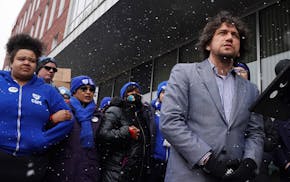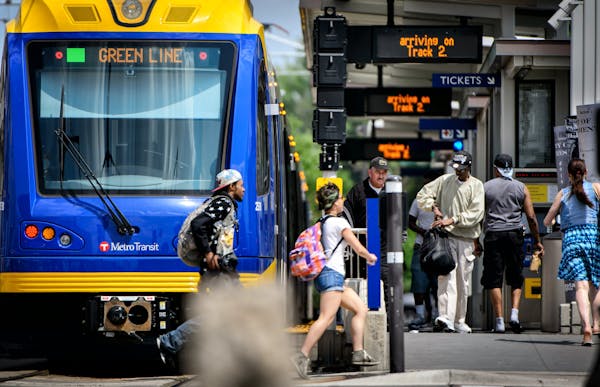At first glance, they seem to be unlikely places for parks: a front yard lining University Avenue, a former circus site and a broken-glass-and-concrete patch shadowed by towering grain elevators.
But more than a year after the Green Line made its inaugural light-rail run, new and renovated green spaces and public places around University are gaining momentum — many the result of public-private partnerships aimed at improving livability and bolstering property values along the tracks.
It's all part of a larger effort, mostly in St. Paul but also in Minneapolis, to leverage the billion-dollar public investment in the Green Line for urban development, while also promoting lifestyles in which walking and biking become easy substitutes for driving.
The goal is not to create large public tracts, but pockets and plazas where residents and visitors can gather, stroll and relax.
"This is the last piece of the puzzle," said Mike Hahm, St. Paul's Parks and Recreation director. "This is a public investment that will return private investment. It really improves the quality of all the things that people want and expect in great cities."
There's a widespread belief that it's needed. Parks make up 15 percent of land use in each of the Twin Cities, but only 4.7 percent in the Green Line corridor — an area expected to add 17,000 households in the next few years. The Trust for Public Land, a national nonprofit conservation group, issued a report last year that said the Green Line was desperately short on green space.
That helped fuel a series of recent park moves in St. Paul. Some examples:
• The St. Paul City Council this month agreed to purchase, along with the trust, three parcels near Griggs Street and University Avenue once known as Circus Hill and now slated for a 5.4-acre park tentatively called 3-Ring or Lexington Commons. The city's share of the $2.5 million deal: $1.5 million from its 8-80 Vitality development fund.
• St. Paul parks recently began landscape work at Iris Park, a cozy urban oasis created on University Avenue in the 1890s but neglected for years. Improvements will include a water fountain, walkways and new plantings.
• Hundreds of yards of sand, silt and clay were delivered this summer to Frogtown Park and Farm, an ambitious new 12.7-acre park at Minnehaha Avenue and Victoria Street that will include an urban farm for the production and distribution of food. The park will hold a grand opening Oct. 3.
• Using a Central Corridor Funders Collaborative grant, St. Paul this summer hired city landscape architect Ellen Stewart to work half-time as an open-space planner for transit-oriented development. Among other things, she will encourage developers to include privately owned public spaces — called POPS for short — in their housing and commercial projects.
Best parks in the land
While most of the focus has been on St. Paul's Midway district, a future park and green boulevard also is being planned for a Minneapolis industrial area near the Prospect Park Station by residents, developers, property owners and the Trust for Public Land.
Trust program director Jenna Fletcher recently led a group tour of that area, pointing out the possibilities for a park and transit-oriented development just east of the University of Minnesota.
It used to be that developers overlooked parks, she said, but that's changed. "We no longer have to make the economic case for parks," she said.
As she spoke, a passerby called out, "Guys, know where Surly's is?" — referring to the new brewery and beer hall considered a prime example of Green Line-generated development. He was on a bike, not in a car. Fletcher smiled.
In its annual ranking of big city parks, the trust this spring judged St. Paul and Minneapolis tied for best city parks in the country in terms of access, acreage and facilities. More than 90 percent of residents in each city live within a 10-minute walk of a park, considered the most important metric.
The areas along the Green Line best served by parks, the report said, were the University of Minnesota and downtown St. Paul. Most in need of green space? The Midway area and downtown Minneapolis.
A new funding formula
That ranking served to fuel both sides of St. Paul's most recent parks debate, settled last week when the City Council approved a new way to calculate how much developers of new projects must contribute to a dedicated parks revenue fund.
The new formula is based on square footage, not parking spaces, and is now weighted more than it was before toward residential projects and less on commercial development. Park advocates said the formula doesn't go far enough, while some in the business community think it goes too far and risks stifling development.
City staffers believe the new rates will mean more funding for parks in areas of new development, such as along the Green Line. But Shirley Erstad, executive director of the Friends of the Parks and Trails of St. Paul and Ramsey County, said the rates are lower than necessary and that the new parkland dedication ordinance contains too many loopholes to make a difference.
"Parks are an amenity that the people of today and tomorrow want," Erstad said. "If we can build that into our system as we're building it out, it will make economic and environmental sense."
Meanwhile, two current but underdeveloped parks are getting fresh attention from St. Paul. Work to relocate parking has begun at Dickerman Park, a quarter-mile grassy strip fronting two blocks along University Avenue that city officials want to turn into a strolling park. The $5 million project was launched with $2 million from St. Paul's 8-80 fund.
City officials also are seeking funding for Pedro Park, a downtown square currently planted with flowers to prepare the soil for permanent plantings. They plan to eventually tear down the adjacent police annex building to expand the park to half a block.
There's a lot of work ahead, Hahm said, but it's well begun.
"It's exciting to see the plans along the Green Line advance from concept into something the community's going to see," he said.
Kevin Duchschere • 651-925-5035

Lakewood Cemetery in Minneapolis opens new Welcome Center
Man killed in domestic incident in Coon Rapids, Sheriff's Office says

U of M's interim president meets with pro-Palestinian protest leaders

Legendary boys hockey coach Randolph loses his job

